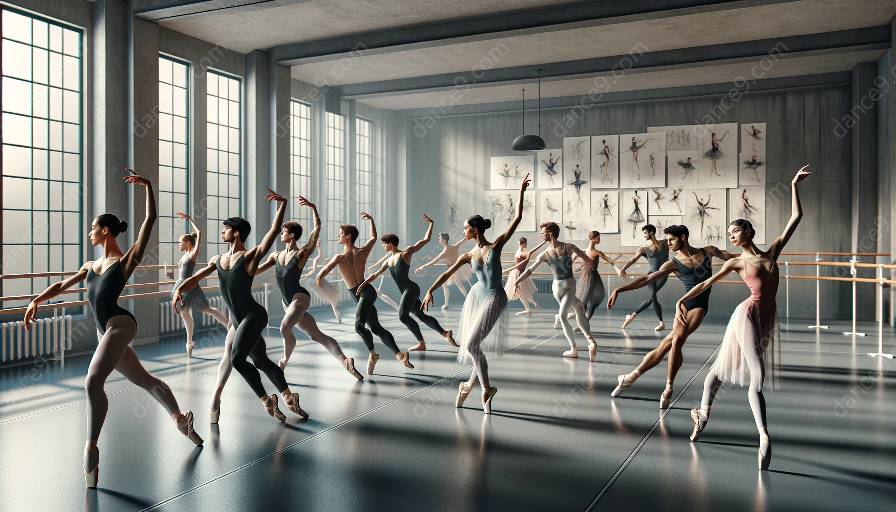Ballet choreography, as a form of artistic expression, is deeply connected to philosophical concepts that shape its meaning, aesthetic, and emotional impact. Understanding the philosophical underpinnings of ballet allows for a richer interpretation and appreciation of this art form. This exploration will delve into the intricate relationship between philosophical concepts and ballet choreography, taking into account the historical and theoretical frameworks that have influenced the evolution of ballet as a distinct form of artistic expression.
The Interplay of Philosophical Concepts and Ballet Choreography
Philosophical concepts influence ballet choreography in a myriad of ways, shaping the creative vision of choreographers, the emotional resonance of movements, and the overarching thematic content of ballet performances. By examining the relationship between philosophical concepts and ballet choreography, we can gain insight into the deeper layers of meaning embedded in the art form.
Ballet as a Reflection of Existentialism
Ballet choreography often reflects existentialist themes, delving into the human experience, individual identity, and the search for meaning. Existentialist philosophy emphasizes the importance of individual freedom, choice, and authenticity, elements that are mirrored in the expressive movements and emotional depth of ballet performances. The exploration of existentialist themes in ballet choreography invites audiences to reflect on the human condition and the complexities of existence.
Plato's Forms and the Idealization of Ballet Movement
Plato's philosophy of forms, which posits the existence of ideal, timeless archetypes, finds resonance in the meticulous precision and idealized beauty of ballet movement. The pursuit of perfection in form and expression within ballet choreography can be seen as a reflection of the Platonic ideal, where the physical world attempts to embody the transcendent realm of pure forms. This connection infuses ballet with a sense of transcendence and universality, elevating its significance as an art form.
Utilitarianism and Social Commentary in Ballet Themes
Philosophical theories such as utilitarianism, which assesses the moral worth of actions based on their consequences and impact on society, often influence the thematic content of ballet choreography. Ballet performances may serve as a platform for social commentary, addressing issues of justice, inequality, and human suffering. Through the portrayal of such themes, ballet choreography becomes a vehicle for engaging with philosophical questions and stimulating critical reflection on societal values and ethics.
Historical Context and Theoretical Frameworks of Ballet
Understanding the philosophical dimensions of ballet choreography requires an exploration of its historical development and the theoretical frameworks that have contributed to its evolution as a distinctive art form. The history of ballet encompasses a rich tapestry of cultural, social, and artistic influences that have shaped its expression and significance.
The Renaissance and the Emergence of Ballet as an Art Form
The origins of ballet can be traced back to the Italian Renaissance, where court entertainments and spectacles developed into early forms of dance and theatrical performances. The fusion of music, poetry, and dance during this period laid the foundation for the evolution of ballet as a disciplined art form with its own expressive vocabulary and technical prowess.
Romantic Era and the Rise of Ballet Narrative
The Romantic era witnessed a significant transformation in ballet choreography, as narratives and emotional storytelling became central to performances. This shift in focus allowed ballet to explore philosophical themes of love, passion, and the supernatural, infusing the art form with heightened emotional expressiveness and dramatic depth.
Modern Ballet and Experimentation with Philosophical Concepts
The evolution of ballet in the modern era has seen choreographers experimenting with diverse philosophical concepts, pushing the boundaries of traditional ballet conventions and embracing contemporary themes and ideologies. The incorporation of avant-garde movements, interdisciplinary collaborations, and innovative storytelling has expanded the philosophical scope of ballet choreography, enriching its artistic expression and relevance in a rapidly changing world.
Structuralism and Semiotics in Ballet Interpretation
Theoretical frameworks such as structuralism and semiotics provide valuable tools for interpreting ballet choreography, as they offer analytical methods for uncovering underlying symbolic structures and meanings within dance performances. By applying structuralist and semiotic approaches, scholars and audiences can engage with ballet choreography on a deeper philosophical level, deciphering the intricacies of its symbolism and narrative construction.
Embracing Artistic Expression through Philosophical Inquiry
The exploration of philosophical concepts in ballet choreography serves as a gateway to understanding the profound artistic expression embedded within this timeless art form. By delving into the interplay between philosophical ideas and ballet movements, we can unravel the layers of symbolism, emotion, and universal truths that resonate through the medium of dance. Through this inquiry, we gain a deeper appreciation for the transformative power of ballet as a vehicle for conveying complex philosophical themes and embodying the human experience.





























